Where to go in Switzerland on a short trip: Alps, lakes, and cities
Switzerland is an extremely popular country for those planning multi-stop tours around Europe, yet very few potential first-time visitors actually know specifically where they want to go. Everyone seems to know that it has the most beautiful views of the Alps and some very impressive cities, but there are actually many misconceptions among casual trip planners, so I’d like to clear most of that up below. The places to visit in Switzerland are not obvious until you’ve been there yourself or done many hours of research, so the list below should be a short cut.
I get hundreds if not thousands of itinerary questions for people who are considering a Eurail trip around Europe, and most people just include the word “Switzerland” among a list of cities like Paris, Rome, and Berlin that they want to visit. So where in Switzerland should you go if you can only make a few stops at most? I’ll answer that question below.
Note: This article was expanded and updated in February, 2024.
Switzerland is about outdoor views rather than city visits
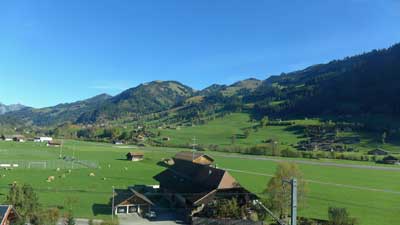
Geneva is a very famous city (though not for tourism reasons) on a lovely lake of the same name, but it’s also notoriously dull and lacking distinction. Rick Steves puts it well by saying that “Geneva is pleasantly situated on a lake, like Buffalo or Cleveland.” The point is, you don’t want to go to Geneva unless you’ve got something specific in mind that you want to see there.
Switzerland's cities in summary
Zurich – The largest city, very expensive, geared towards business travelers. It’s generally a pretty and very well-run city that you would enjoy if you visited, but it’s not nearly as interesting as the likes of Vienna, Munich, or of course Paris.
Geneva – Second largest city, in the French part of the country, no major sights. Again, if you visited you’d be very impressed by it and get some great photos, but it’s not worth your time unless you know someone there. There’s an impressive fountain in the lake and you can usually see it from the train as you go through the city, but it’s not really worth going there and staying more than an hour or so.
Basel – Bordering France and Germany, no major sights. It has the famous art market each year, and aside from that it’s even duller than the ones above. Again, if you visited you’d be impressed, but if you later compared photos with friends who went to the Lauterbrunnen Valley instead, you’d kick yourself for going to Basel.
Lausanne – Near Geneva in the French part of the country, very hilly, and certainly more interesting than Geneva.
Bern – The capital, compact, on a lovely river, some interesting sights and the best Swiss city to get a feel for the culture. Bern is fairly close to Interlaken (which we will discuss below) and it can be a great day trip from there, especially on a day where it is foggy and/or rainy in the mountains (and this happens a LOT).
How much time and which Swiss cities to visit?
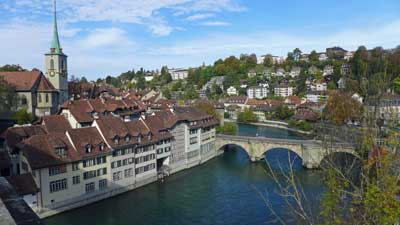
Many people (me included) don’t feel as if they’ve scratched the surface of a new country if they haven’t spent at least a day or two in the largest city. Zurich is certainly pleasant and a useful transit hub so spending one or two nights there wouldn’t be a major mistake. But Zurich isn’t even close to being a city like Paris, Rome, Berlin, Amsterdam, or even Vienna. If you skip it in favor of spending more time in the outdoors, you won’t be missing much.
The 2 Swiss places to focus on for short visits
Interlaken – If you want the best possible Alpine views and activities, head to the Interlaken area, which will be described in detail below.
Lucerne – The traditional Swiss tourist retreat, Lucerne is a small city with interesting culture and sights, that is gorgeously set on a lake with plenty of top activities surrounding it.
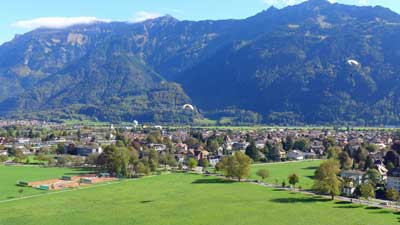
>>>Interlaken and Lucerne: Which to choose and how long to stay in each?
The article linked above will give you more details on which to choose and how long to spend in each place.
What about Zermatt for Alpine views?
Zermatt is a remote car-free village in southern Switzerland that is famous for being the place to see the Matterhorn mountain. It’s also a busy ski resort area, and aside from that, there isn’t much to see or do here. It’s on a private rail line, so it’s more complicated and usually more expensive to reach than Interlaken.
In other words, unless you’ve irrationally placed “Seeing the Matterhorn in person” on your so-called bucket list, skip Zermatt and head to Interlaken on a shorter visit. You won’t be sorry. If you already have enough time in your visit for the main sights around Interlaken and Lucerne and you want to also see the Matterhorn, then by all means go and you’ll enjoy it. There are quite a few other car-free villages in the Lauterbrunnen Valley near Interlaken, so they are not as novel in Switzerland as one might expect.
A weekend in Switzerland?
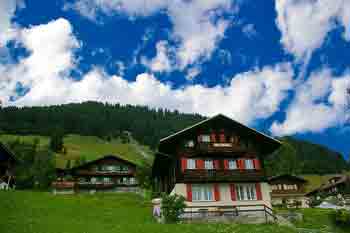
One challenge is that neither has an international airport so you’ll either be flying into Zurich or perhaps Geneva.
Train times from Zurich to Lucerne to Interlaken and back
- Zurich Airport to Lucerne: 1 hour 10 minutes by train
- Lucerne to Interlaken: 2 hours by train
- Interlaken to Zurich Airport: 2 hours 15 minutes by train
As you can see with the travel times above, Zurich Airport to Lucerne is a fairly short trip, but once you add Interlaken into the mix (even if you skip Lucerne) the travel time starts to add up for a weekend visit. With this in mind it’s probably best to just choose one of them and save the other one for another trip.
Lucerne is gorgeous, but the Lauterbrunnen Valley near Interlaken is really the star of the show, so I’d recommend going there first and doing Lucerne on another trip.
What about the Swiss Travel Pass?
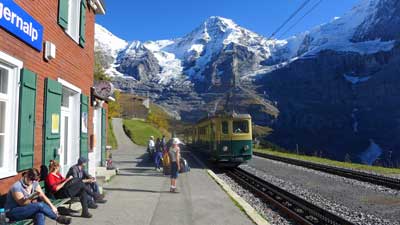
The bottom line is that if you are coming to Switzerland for at least 3 days and you want to take 2 or more of the amazing scenic rail journeys that the country is famous for, the travel pass is probably a good deal. It also provides 50% discounts on the Schilthorn cable car and 25% off the Jungfraujoch mountain railway. Both of those are quite expensive on their own, but extremely worthwhile, so the discount is helpful.
The Half Fare Card is probably a better deal for most people
The Swiss Travel Pass is a good deal for those who are going to be spending at least 2 or 3 days riding the rails and seeing Switzerland that way. But if you are mostly going to be focusing on Interlaken and Lucerne and the mountain sights, the Half Fare Card is the best option. For CHF120 (about US$134) you get the card that is good for 30 days and gives you a 50% discount on all trains, cable cars, mountain railways, and other sights and attractions. If you are doing either Schilthorn or Jungfraujoch, the Half Fare Card practically pays for itself with just one of those.
>>>Buy the Swiss Half Fare Card
Many people have questions about the Swiss Half Fare Card so I will explain it a bit here. You can actually buy half price train tickets for travel within Switzerland any time you want and you will see that option when you go to buy them online. The only thing is you have to have and present a valid Half Fare Card when you get on the train and are asked to see your ticket. In other words, you can buy a half fare train ticket today and buy a Half Fare Card just before you get on that train months in the future, and you are fine.
How and why visit the area around Interlaken
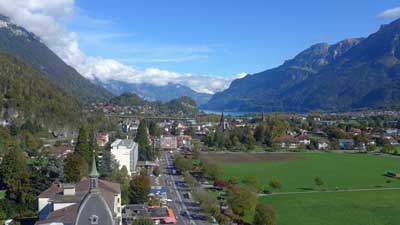
You can see everything discussed below by actually staying in a hotel in Interlaken, but it’s not the Alpine experience that you get if you stay in one of the small villages nearby. You can reach those villages in 20 to 40 minutes from the Interlaken Ost (East) train station, and it’s much easier than it sounds.
The 3 best places to stay to visit the Swiss Alps
Lauterbrunnen – A private train line runs from Interlaken Ost station to the end of its line in Lauterbrunnen. There’s a lovely waterfall here and great hiking trails, but you should probably only stay here if you can’t get to one of the villages mentioned just below. It’s a great little transit hub and it’s definitely gorgeous, so it can be worth a night if you’ve got one to spare.
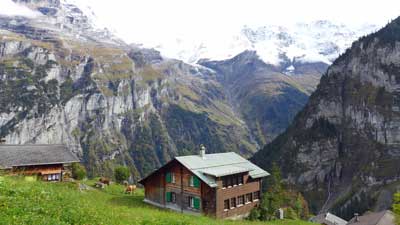
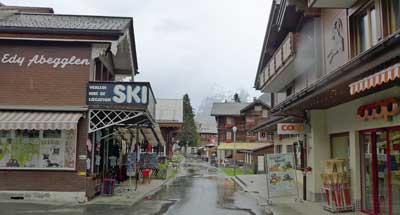
Where to stay in Interlaken and the Lauterbrunnen Valley (with pics)
I get so many questions about where to stay in the Interlaken area that I decided to write a longer version of it and load it with huge photos so readers can get a better feel for each option. I also included recommendations for affordable and well-located photos in each area.
>>>Where to stay in Interlaken and the Lauterbrunnen Valley New for 2024!
The unforgettable things to see here (if the weather is decent)
Schilthorn observation deck and restaurant
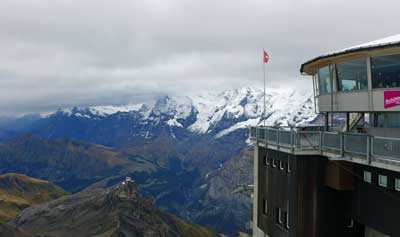
There is a rotating restaurant (with prices similar to normal Swiss restaurants) and a bizarre and anachronistic James Bond attraction based on it being a key location in the 1969 movie On Her Majesty’s Secret Service. The Bond thing is included with the lift, and it’s worth a look.
But the main thing you come here for is the 360-degree view from one of the highest peaks in Europe. Again, the weather here is key, but fortunately all the locals track the visibility on a minute-by-minute basis. If it’s clear up top while you are in the area, it would be a terrible shame to skip it based on the high price. But even if it’s cloudy up top, there are still plenty of wonderful things to see and do in the villages below.
Jungfraujoch observation area
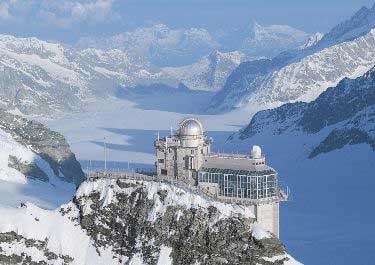
The views from the top are similar to the views from Schilthorn, from the other side of the Lauterbrunnen Valley. Once on top you can have lunch, hike, or even go sledding. It’s also quite expensive at nearly US$200 round-trip unless you have a Swiss Pass or a Eurail Pass for discounts, and it takes most of your day, but you’ll never forget the views from the top.
Harder Kulm mountain and Two Lakes Bridge Observation Deck
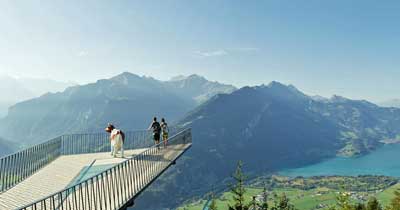
There’s a revolving restaurant about 10 minutes’ walk from the station at the top, which is definitely an unforgettable place for lunch if you’ve got time. It’s not as expensive as you might expect, at least compared to normal restaurants in Switzerland.
The Harder Kulm Railway goes from early April through late November each year. If you are only in Interlaken for one day and/or you are on a strict budget, this is the fastest and best way to get amazing Alpine views in the area.
Getting from Interlaken to Gimmelwald and Mürren
Getting up to these villages sounds complicated and time consuming, but it’s actually fast and easy once you get there. This little guide should help.
Arrive in Interlaken
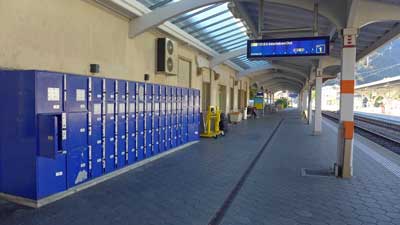
Once you arrive at the Interlaken Ost train station, head for the ticket windows in the office and buy a ticket to your final destination (Lauterbrunnen, Gimmelwald, or Mürren). Eurail passes are good for 25% discounts on the rest of the trip, but not for the whole thing.
From Interlaken Ost to Lauterbrunnen
The private train leaves Interlaken Ost every 30 minutes and arrives in Lauterbrunnen 20 minutes later. If you are staying in Lauterbrunnen then you are probably walking distance from your hotel when you reach the station.
From Lauterbrunnen to Gimmelwald
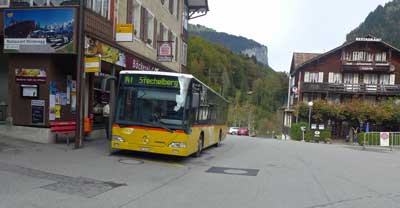
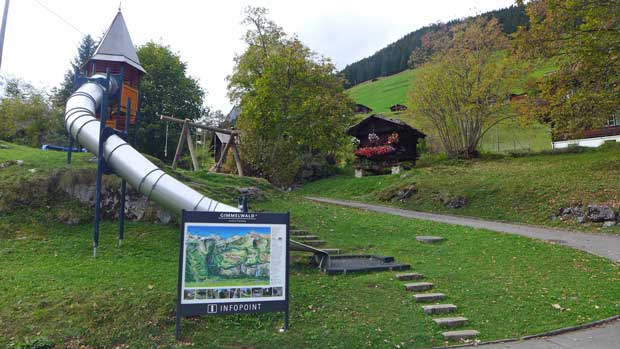
From
Gimmelwald to Mürren
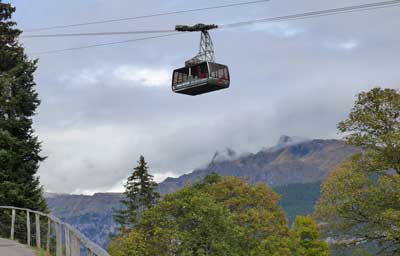
Recommended hotel and hostel in Gimmelwald
I get asked all the time about where to stay in Gimmelwald, so here it is:
Hotel: Esther’s Guesthouse
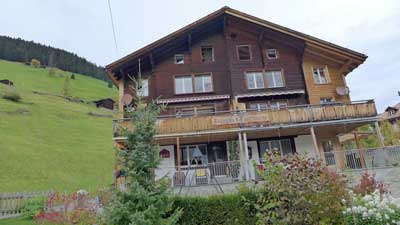
It’s run by Esther, as you might guess, and she is very friendly speaking excellent English. Each room is different and the place feels like a mountain cabin, because it is. She offers an excellent buffet breakfast in the morning, which you have to order the night before. It’s not cheap, but it’s worth it because it’s hearty and there are no other good options nearby.
Book as early as possible because this place is often the first place to sell out in Gimmelwald.
Hostel: Mountain Hostel Gimmelwald
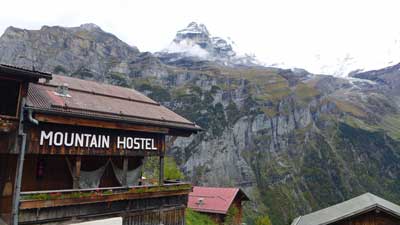
You won’t believe the views from this place, which are the same as from Esther’s except a bit lower and more unobstructed. This place also has a busy bar and restaurant that is basically the only “nightlife” in Gimmelwald. Many hikers get to bed early in this tiny village, but if you want to have a couple drinks and order a pizza or some local options, this is the place to go.
Again, book early because this place is always sold out.
Lucerne and what to do there
Luzern, as it’s spelled locally, is the other traditional holiday destination in Switzerland. Unlike Interlaken, Lucerne actually qualifies as a small city rather than a small resort town, so it’s a very nice contrast and very worthwhile.
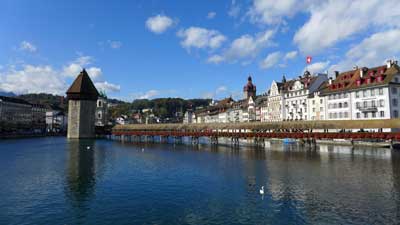
However, unlike Interlaken, the town of Lucerne itself is a great attraction and worth at least a day of exploration. This has always been a rich area so you can expect to find all of the high-end shops and boutiques along the small streets just north of the lake, but there are also many traditional shops and things to see that will appeal to anyone.
Recommended hotel in Lucerne
>>Hotel Des Alpes (3 stars with an amazing location and view)
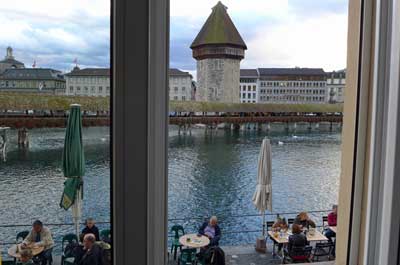
If this place is booked, which is often the case, then book a hotel as close to it as you can find or afford. The whole historic part of town surrounding it is lovely, with restaurants, bars, and high-end shops. There are also a couple of nearby supermarkets where you can buy inexpensive alcohol and picnic supplies to keep other costs down.
Spend a day in Lucerne itself
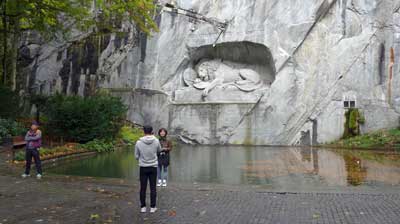
Most of the interesting part of Lucerne is in the area behind those restaurants, and it’s certainly worth doing a self-guided walking tour if not a guided one. Heading farther east you’ll come to another older part of town where the famous lion statue is located. You can’t visit Lucerne without having a look at the lion, and fortunately it’s easy and quick to reach (and it’s free).
Take a lake cruise of some kind
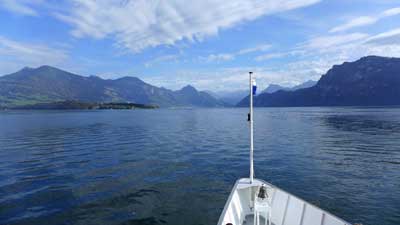
Especially in nice weather, even the short lake tour is lovely, and if you have more time you can jump off at Vitznau and do the scenic hike up Mount Rigi. There are also small lakeside villages that are ideal for a stroll and lunch stop. Long story short, there are dozens of interesting sightseeing options that are available using part of the boat tour, and the views all around are wonderful.
Visit Mount Pilatus
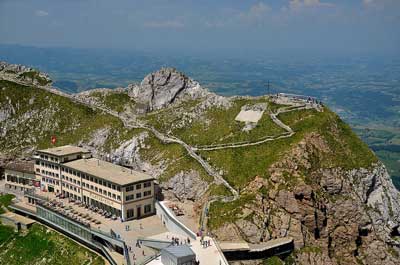
You can take the cogwheel train up and have a more or less flat hike around the summit area, and then take the gondola and cable car back down again. You can do them in the other order, and the cost is the same either way. At around US$65, this is not a cheap hike, but like most everything in Switzerland, the quality is high so it doesn’t feel like a rip-off. You can reach the cable car in 10 minutes on a public trolly bus from Lucerne.
Visit Mount Rigi
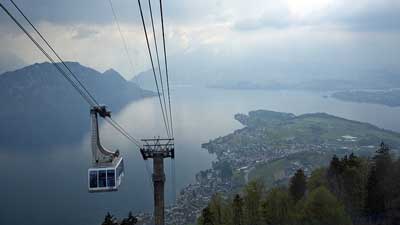
Unlike the other peaks mentioned in this article the Swiss Travel Pass covers both ways to get up and down for free. The others are 50% off with the Swiss Travel Pass or Half Fare Card, except for Jungfraujoch, which is only 25% off with the Swiss Travel Pass and still 50% off with the Half Fare Card.
Visit Mount Titlis
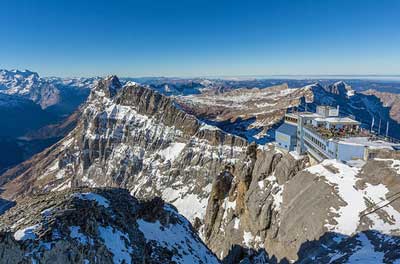
You can reach Titlis by taking a 43-minute train ride from Lucerne to Engelburg and then taking the cable car up from there. As with the others, it’s wise to check the weather immediately before you are going to depart because it can be foggy or cloudy any time of the year, but usually not for whole days at a time.
Additional photo credits
Jungfraujoch by cupweuro on Flickr, Pilatus by Tony Fernandez on Flickr, Rigi by Kosala Bandara on Flickr, Titlis by PaulSchliebs on Flickr

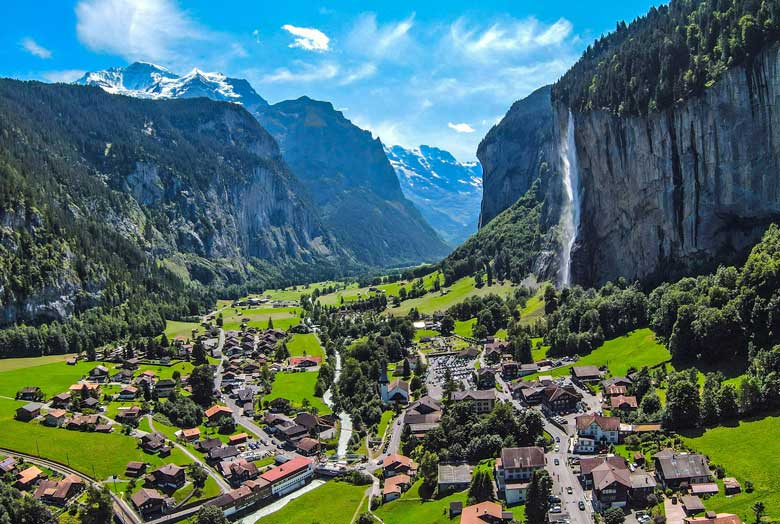
Hi Roger,
Big fan of your blog and I keep coming again and again to get more insights as to how I should plan.
We are doing Europe tour of 3 weeks and plan to Visit Switzerland on 19th May from Paris and plan to spend 5-6 days here.
Couple of questions for you,
1. Coming from Paris where should we go first in Switzerland.
2. Interlaken and Lucerne are our primary interests. How should we split our time in these two places given we would be in Switzerland for 5/6 days.
3. Do you recommend any other places while we stay in Switzerland.
As always very thankful.
-Ashish
Ashish,
Sorry about missing this for a few days. It’s easy for me to see questions from first-time commenters, but the ones from previous commenters can blend in.
My top recommendation would be to spend 3 nights in Interlaken and 2 or 3 nights in Lucerne. As mentioned near the top of the article, if you want to spend a day in a Swiss city (possibly if the weather in the mountains is foggy or really rainy) the best one is Bern, which is small enough to enjoy as a day trip.
From Paris you’ll be changing trains in Basel at the border. You could go from there to Lucerne and then to Interlaken or the other way around and it will end up the same in the end. For those who are heading to Italy next, it’s better to end in Interlaken because it’s much closer to the train through the Alps to Milan. But if you are going back to Paris or in that direction it will end up being the same loop.
Those two cities are the best options for your entire 5 or 6 night stay, partly because they are quite different from each other. The town of Lucerne is lovely, but it’s very touristy and a little cheesy, so I recommend staying 2 nights in one of the villages in the Lauterbrunnen Valley for an unforgettable experience. You might stay your first or last night in Interlaken itself, and you’ll enjoy that as well.
On the other hand, the city of Lucerne is quite a bit bigger and also the city itself is really stunning with the Chapel Bridge at its heart. So you’ll want to stay as close to that bridge (and to the nearby train station) as you can for the most convenient transport links. And again, if you have a day that looks like it’s going to be bad weather in the mountaintop areas you can visit Bern on a day trip from either of those places. Let me know if you have any other questions. -Roger
Thank you so much for the help and your expertise. I have learned so much from your articles and have planned our trip based on your blog. So looking forward to seeing Switzerland.
Thanks again, Kim
Hi, We are traveling to Interlaken and want to do Schilthorn and Jungfraujosh We were thinking that we would like to stay in Murren instead of Interlaken. We decided to buy the Swiss Half Fare card. Is the price still $205 from Murren to Jungfraujosh or is it more? Do we have to leave from Interlaken to get to Jungfraujosh? Also since we are in Murren, is it still $112 for the cable car to Schilthorn? Hopefully my questions make sense to you. Thanks for your help. Kim
Kim,
I think the idea to stay in Murren instead of Interlaken is great and you’ll be thrilled with your choice once you get there. The main transit hub for all of the main attractions is the village of Lauterbrunnen, which is a 20-minute train ride from Interlaken Ost station. To get from Murren to Jungfraujoch you only have to go back to Lauterbrunnen, which is two short cable car stops down the hill and then a bus ride from the cable car station in Stechelberg to the Lauterbrunnen train station. I think that will cost around CHF12 to 15, so if you have the Half Fare Card it will cost half of that. Better still, it’s a gorgeous ride and the bus even passes a big waterfall on its short trip.
The cable car from Murren to Schilthorn will be about CHF10 less since you are already a short way up the mountain, and you’ll of course pay half of that. Let me know if you have any other questions. -Roger
Hi Roger,
I have found you blog very useful. As a matter of fact I am planning and tweaking my itinerary based upon you comments.
You are doing a great service to us fellow travellers 🙂
Me and my wife are planning for a 5 day trip.
Few questions that I have and was wondering if you could answer.
1. We are spending 3 nights in Interlaken and 2 nights in Lucerne. Does this sound good. If we could put in another day to our trip, how do you think we should spend it. Is Montreaux a worth while idea.
2. When is the better time to visit – April or May in terms of weather.
3. I am slightly confused as to where should we base our stay at – Interlaken or Gimmelwald or to split time at both places.
4. Switzerland is part of our Europe trip. How should we approach Switzerland. Amsterdam > Paris > Switzerland > Italy or in the reverse order i.e. starting from Italy > Switzerland > …
Thanks,
Ashish
Ashish,
I’m happy to hear that this has been helpful and I’ll try to answer your questions.
1. Montreux, Lausanne, and Geneva are all really nice-looking cities with gorgeous locations overlooking Lake Geneva. But compared to the amazing scenery, the cities don’t really measure up. You might consider doing the GoldenPass scenic train journey if you have time, as it goes through all of those cities and has much more great scenery as well. If you want one Swiss city to visit I’d recommend Bern, as mentioned at the top of the article. It’s also got a gorgeous location on a winding river and the historic center is more striking than the others. Somehow, Switzerland is blessed with some of the world’s best scenery and yet its cities are mostly kind of dull by European standards.
2. The slightly warmer May weather might be nicer than April, but those months shouldn’t differ much when it comes to the rest. The ski season is usually over by early April and the hiking season doesn’t pick up until May, so you might have smaller crowds and slightly lower hotel prices in April.
3. If you can spend 2 nights staying in Gimmelwald itself, it will be an unforgettable time, but it’s really a tiny village so I wouldn’t stay more than 2 nights. It’s actually pretty easy to move around in the Lauterbrunnen Valley and up the cable cars, so you might stay the first two nights up there and your third night in Lauterbrunnen or Interlaken itself.
4. As for whether to start in the south and go north, or the other way around, it’s probably better to start in the south and go north because the weather in the north should get a little better as April and May go on. But you might not notice a difference so really either way would be very enjoyable. Let me know if you have any other questions. -Roger
Hi Roger,
We are planning a trip to Switzerland in June. We are flying into Basel. Is there a train from Basel to Interlaken? We plan to spend 2 days in Gimmelwald, Is there a train that would take us from Interlaken to Luzerne. We plan to spend a day in Luzerne. We then have to find our way to Munich or Regensburg to catch a river cruise from Regensburg. Do you have any suggestions on how we could get there?
Look forward to hearing from you.
Cheryl,
I answered part of this question under another comment. The train between Interlaken and Lucerne takes 2 hours and is yet another gorgeous ride and it’s actually part of the GoldenPass scenic route.
From Lucerne to Munich the best way is almost certainly to change trains in Zurich (1 hour from Lucerne) for an international train to Munich and then onward. You can check timetables at the Swiss rail website. Let me know if you have any other questions. -Roger
Hi Roger,
We are planning a trip to Switzerland in June. We arrive in Basel and would travel directly to Gimmelwald where we will stay for 2 nights. We will then stay in Luzerne for 1 night. We then need to travel to Munich or Regensburg from where we will take a river cruise.
1. Do you know if there is a train from the Basel airport that would take us to Gimmelwald.
2. Should we stay for all three nights in Gimmelwald and travel to Luzerne and back, or is it better for us to stay one night in Luzerne.
3. Where would we get a direct train to travel to Munich or Regensburg
Thank you so much for your advice.
Cheryl,
From Basel Airport you can take a taxi or Airport Bus to the Basel SBB train station and then a train to Bern and then a train to Interlaken and then a train to Lauterbrunnen and then a bus to the cable car station and then a cable car up one stop (5 minutes) to Gimmelwald. It sounds complicated, but you can get it all on one ticket starting from the Basel train station. Almost all of it is extremely scenic as well, so it’ll be a wonderful journey.
Gimmelwald is a magical little village and you’ll never forget staying there, but it’s tiny and I think 2 nights is enough. Lucerne is also gorgeous (and totally different) and I think spending the night there is very worthwhile.
From Lucerne you can take a train in one hour to Zurich and from there you have many options of direct trains into Germany. You’ll be able to buy the ticket all together from Lucerne all the way to your final destination in Germany.
Let me know if you have any other questions. -Roger
Hi Roger!!! I stumbled across your guide while planning a trip to Switzerland and wow thanks so much for all your recommendations!! It will be my first trip there together with my partner so I would like to ask for some advice!
We are planning to go there from 8 June to 15 June 2020, roughly 7 days or lesser if you include flight travel. Was thinking of taking a flight to Geneva and go on to Interlaken and Lucerne from there! Not sure if we are missing out by skipping Bern
What are the number of days you would recommend us to stay for each area and which attractions to look out for?
Also, would it be good to stay in Geneva and travel to the other 2 areas or to shift our accommodation around?
Lastly, wanted to ask if the Swiss Travel Pass or the Swiss Half Fare Card would be better in this case?
Looking forward to your reply and thank you so much in advance for all your help!!
Many thanks,
Bel
Bel,
I think your plan sounds quite good. Flying into Zurich is closer than flying into Geneva, and usually cheaper as well, but if you can get cheap airfare into Geneva it will work just fine. I’d plan on staying 3 days in the Interlaken area and 3 days in Lucerne. Bern is very nice, but I think it’s best to save it as a back-up plan in case it’s too foggy in Interlaken to go up the mountains. You can get from Interlaken to Bern in an hour, so it should be pretty easy to go there for half a day during your visit if you are in the mood when you are there or if the weather is bad elsewhere.
Geneva is a lovely city on a lake, but there isn’t much to do or see and the real magic of Switzerland is in the Alps. I wouldn’t stay in Geneva unless you had to to catch an early flight. It’s a pretty long train ride from there to Interlaken as well.
It’s hard to say with confidence but the Swiss Travel Pass for 8 days is probably your best and cheapest option, although a Half Fare Card with the option to buy a Saver Day Pass or two could also work. I’d recommend you plan on getting a Swiss Travel Pass and then build your itinerary out of the things that are fully included with the pass such as Mt. Rigi and the lake cruise and the various cable car rides. Let me know if you have any other questions. -Roger
Hi Roger !
I’m planning to travel solo to Switzerland and Amsterdam during Christmas break. Is it a good idea? haha. I will be arriving in Zurich on 22 Dec at 19.45 from Salzburg.
My itinerary is:
– 22/12: Zurich – Interlaken/Lauterbrunnen (will the train after 20.00 available? also, i can’t decide whether I should base in Interlaken or Lauterbrunnen 🙁 )
– 23/12: Jungfraujoch (it’s expensive i know, but it’s on my bucket list)
– 24/12: Zermatt? or going around Lauterbrunnen, Gimmelwald
– 25/12: Zurich to Amsterdam by plane.
Thing is, I saw many swiss passes which make me confuse. Many pages write that half fare card is the best deal to visit Jungfraujoch. Is it true?
Many thanks,
Rocha
Rocha,
I think your idea is a good one. There should be plenty of snow in the Swiss mountains and it’s really beautiful that way. Lauterbrunnen is a gorgeous little village in the valley, but there aren’t too many choices of restaurants and such. Interlaken is not the coolest town, but at least it’s filled with hotels and restaurants and all that, so it could be a better choice for a solo traveler depending on your tastes.
I’d probably save Zermatt for another trip because there is so much to see in the Interlaken area and getting to Zermatt is kind of a hassle. But if you went I’m sure you’d love it.
If you are doing Jungfraujoch then the Half Fare Card is almost certainly your best choice because you get 50% off compared to only 25% off with the Swiss Travel Pass. If you go to Zermatt you’d get more use out of the Swiss Travel Pass, but the Half Fare Card still might be the better deal. Let me know if you have any other questions. -Roger
Slight correction in above post.
Hi Roger,
I am planning to travel to Switzerland from Pune India with my friend from Oct19th to Oct26th 2019 , is this a good season to travel?
Day1 – Land in Paris at 7PM and take bus to Geneva (booked)
Day2 – Reach Geneva at 6AM and head to lauterburnnen and reach there at 9AM , checkin to hotel at 9AM in Jungfrau base camp hostel , do you know how is this hostel? Visit Schilthorn and near by villages like Murren , Wengen etc. , what should be the sequence to visit all these villages efficiently?
Day3 – Stay overnight in Lauterbrunnen , do you recommend visiting Jungfrau provided I am already visiting Schilthorn which comes free with Swiss pass. Also if I not visiting Jungfrau then what else can I do on this day?
Day4 – Start for Lucerne and reach there by 9AM and checkin holiday inn hostel in Krienz Lucerne hotel , Visit Mount Rigi and boat cruise which is part of trip to Mount Rigi etc , this is also included in Swiss Pass
Day5 – Overnight stay in Lucerne ? What should I do on this day? Is Zurich a good visit or should I visit something else?
Day6 – Move from Lucerne and reach Zurich to catch train to Paris and reach Paris by 3PM , go for Siene river cruise and visit Eiffel during night
Day7 – Visit Louvre , Champs de elysse , arc , other monuments/museums etc
Day8 – Overnight Journey to India , flight is at 10PM , what can I do on this day in Paris? Disney land or Versailles or something else as I have to start for Paris Airport at 7PM.
Can you please suggest if this is good itinerary? Also what are the best places to visit on each day and must visit places on each day?
Also is swiss travel pass for 4 days a good idea for this itinerary? Also should I visit mountain excursions which are not included in the Swiss pass , are they worth it for price?
Thanks Roger.
Ravi,
I’ll try to answer your questions in order…
Late October should be a fine time to visit Switzerland as it’s really a year-round destination. However, the summer hiking season ends around October 15 and the ski season usually begins around December 15, so many of the smaller hotels and restaurants in the mountain villages are closed for those two months. Other places stay open so it shouldn’t be difficult to find hotels and restaurants, but it’s worth noting that this is a slow time of year. The summer months are actually the rainy months in the Alps, so October is usually fairly dry and not too cold yet.
I don’t know that Jungfrau hostel, and it appears to be new, but Lauterbrunnen is a perfect base for a trip like this.
As for what order to do things in that first day, it really depends on the weather. It can be foggy or very cloudy on top of those mountains any day of the year, but it’s usually only for a few hours at a time. Often it’s clear in the morning and foggy in the afternoon, or sometimes the other way around. So if Schilthorn is clear on top in the morning (there are webcams and the hostel people can also tell you), I’d go up as early as possible and the on your way down you can get off the cable car in Murren for a walk around and then walk down to Gimmelwald (about 15 minutes) and then down the cable car again towards Lauterbrunnen. If it’s foggy at Schilthorn in the morning you can go to Wengen first and then hope for clear weather a little later.
Schilthorn and Jungfraujoch are very different experiences, but Jungfraujoch is very expensive and it’s across the Lauterbrunnen Valley from Schilthorn, so I might save that for another trip. Having another open day in Lauterbrunnen will be great in case the weather up top is foggy. There is a great hike from a cable car that goes up from Wengen, so you could do that on the second day. Lauterbrunnen also has waterfalls and you can rent bikes. There are plenty of great options and you can decide when you get there.
On Day 5 you can wander more around Lucerne and visit the Chapel bridge and Lion statue. Lucerne is really a gorgeous town (much nicer than Interlaken), and you might even do the lake cruise again and get off in one or more of the villages it stops at along the way. I really wouldn’t recommend Zurich unless there is something specific you want to see there. It’s a nice city, but it’s crowded, expensive, and most known for banks.
On Day 8 you’d have time to visit Versailles, which takes about 5 hours for most people. But Paris is packed with excellent sights and you might just stay there until you have to go to the airport. You can get more ideas of things to do on this review of the Paris Pass. Even if you don’t buy a Paris Pass, most of those things are really worthwhile. I highly recommend the hop-on, hop-off bus because the route is really beautiful and allows you to see most of the city center in 3 hours. That should give you more ideas.
I think your itinerary looks great and I don’t have any other suggestions really. It looks like you’ve got all of the best highlights on your list already. I’m sure you’ll find other things to do while you are there, but it looks like you’ve done a great job with the top things.
Based on your itinerary I’d say the 4-day Swiss Travel Pass should be very good value. Just with Schilthorn and Mt. Rigi you’ll be covering about half the price, and all of those train rides and other cable cars and boat rides you’ll do would cost quite a bit more without a pass.
If you DO buy the Swiss Travel Pass I’d probably just do Schilthorn and Mt. Rigi. The other peaks near Lucerne are each really nice, but it takes an hour or two going up and down each time and that can get tiring if you try to visit more than a couple of the peaks on a short trip. There will be no shortage of other great things you can do, and many of those will be fully covered by the Swiss Travel Pass. Let me know if you have any other questions. -Roger
Hi Roger,
Wonderful! Thank you so much for your tips and I just booked a hotel close to Lauterbrunnen train station from 15 till 18 Dec. I think that leaves me plenty of time to explore the area. The idea of taking a train from Interlaken to Milan through the Alps is fantastic! But I can’t seem to find the train ticket for it even on https://www.myswissalps.com/timetable – it only suggested a bus trip though. Does it mean that the train does not operate during December? I read that the suggested train route is Lauterbrunnen – Interlaken – Spiez – Milan – is this correct?
Bill,
I believe the trains operate all year round and that is the route I was thinking of. I just checked for tickets and it looks like the train schedules are only set through 14-December right now, so you can only book through then. The new schedule starting after that should be set by mid October, so you should be able to see the trains and book in a little over a week.
By the way, you should be able to book the trip to Milan through the main Swiss rail website, but you’ll probably get a cheaper fare on the Milan to Rome portion if you book that through Trenitalia. You’d have to change trains in Milan either way, and you might even want to spend an hour or two there looking around at the cathedral before carrying on to Rome, so booking separate tickets could be good. It’s worth noting that the Swiss trains are famously punctual and the Italian trains are not. Let me know if you have any other questions. -Roger